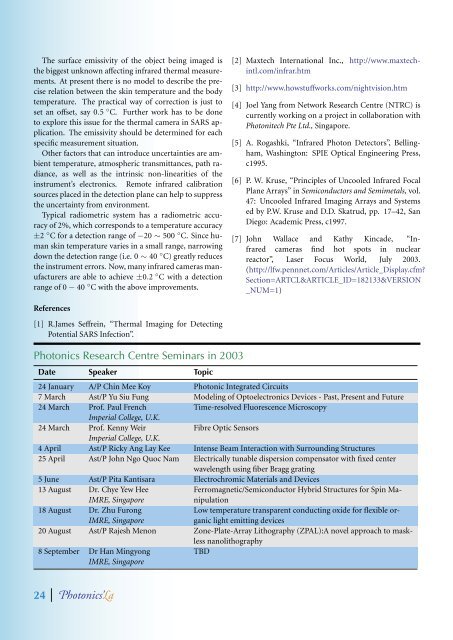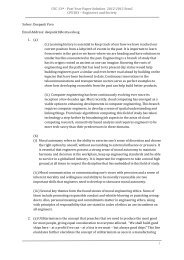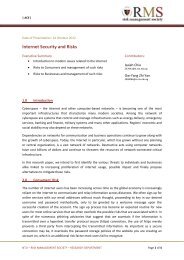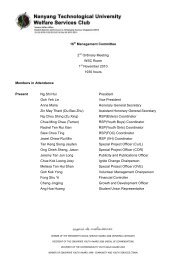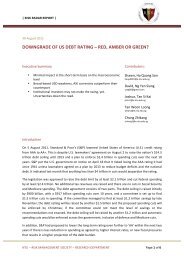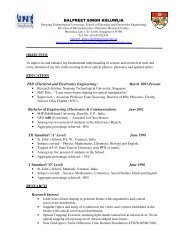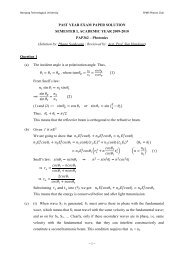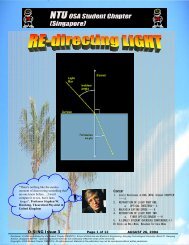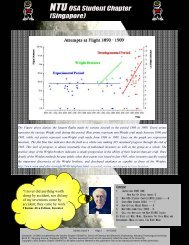PhRC NEWSLETTER PHOTONICS'La - Nanyang Technological ...
PhRC NEWSLETTER PHOTONICS'La - Nanyang Technological ...
PhRC NEWSLETTER PHOTONICS'La - Nanyang Technological ...
You also want an ePaper? Increase the reach of your titles
YUMPU automatically turns print PDFs into web optimized ePapers that Google loves.
The surface emissivity of the object being imaged is<br />
the biggest unknown affecting infrared thermal measurements.<br />
At present there is no model to describe the precise<br />
relation between the skin temperature and the body<br />
temperature. The practical way of correction is just to<br />
setanoffset, say 0.5 ◦ C. Further work has to be done<br />
to explore this issue for the thermal camera in SARS application.<br />
The emissivity should be determined for each<br />
specific measurement situation.<br />
Other factors that can introduce uncertainties are ambient<br />
temperature, atmospheric transmittances, path radiance,<br />
as well as the intrinsic non-linearities of the<br />
instrument’s electronics. Remote infrared calibration<br />
sources placed in the detection plane can help to suppress<br />
the uncertainty from environment.<br />
Typical radiometric system has a radiometric accuracy<br />
of 2%, which corresponds to a temperature accuracy<br />
±2 ◦ C for a detection range of −20 ∼ 500 ◦ C. Since human<br />
skin temperature varies in a small range, narrowing<br />
down the detection range (i.e. 0 ∼ 40 ◦ C) greatly reduces<br />
the instrument errors. Now, many infrared cameras manufacturers<br />
are able to achieve ±0.2 ◦ Cwithadetection<br />
rangeof0− 40 ◦ C with the above improvements.<br />
References<br />
[1] R.James Seffrein, “Thermal Imaging for Detecting<br />
Potential SARS Infection”.<br />
Photonics Research Centre Seminars in 2003<br />
Date Speaker Topic<br />
[2] Maxtech International Inc., http://www.maxtechintl.com/infrar.htm<br />
[3] http://www.howstuffworks.com/nightvision.htm<br />
[4] Joel Yang from Network Research Centre (NTRC) is<br />
currently working on a project in collaboration with<br />
Photonitech Pte Ltd., Singapore.<br />
[5] A. Rogashki, “Infrared Photon Detectors”, Bellingham,<br />
Washington: SPIE Optical Engineering Press,<br />
c1995.<br />
[6] P. W. Kruse, “Principles of Uncooled Infrared Focal<br />
Plane Arrays” in Semiconductors and Semimetals, vol.<br />
47: Uncooled Infrared Imaging Arrays and Systems<br />
ed by P.W. Kruse and D.D. Skatrud, pp. 17–42, San<br />
Diego: Academic Press, c1997.<br />
[7] John Wallace and Kathy Kincade, “Infrared<br />
cameras find hot spots in nuclear<br />
reactor”, Laser Focus World, July 2003.<br />
(http://lfw.pennnet.com/Articles/Article_Display.cfm?<br />
Section=ARTCL&ARTICLE_ID=182133&VERSION<br />
_NUM=1)<br />
24 January A/P Chin Mee Koy Photonic Integrated Circuits<br />
7March Ast/P Yu Siu Fung Modeling of Optoelectronics Devices - Past, Present and Future<br />
24 March Prof. Paul French<br />
Imperial College, U.K.<br />
Time-resolved Fluorescence Microscopy<br />
24 March Prof. Kenny Weir<br />
Imperial College, U.K.<br />
Fibre Optic Sensors<br />
4April Ast/P Ricky Ang Lay Kee Intense Beam Interaction with Surrounding Structures<br />
25 April Ast/P John Ngo Quoc Nam Electrically tunable dispersion compensator with fixed center<br />
wavelength using fiber Bragg grating<br />
5 June Ast/P Pita Kantisara Electrochromic Materials and Devices<br />
13 August Dr. Chye Yew Hee<br />
Ferromagnetic/Semiconductor Hybrid Structures for Spin Ma-<br />
IMRE, Singapore<br />
nipulation<br />
18 August Dr. Zhu Furong<br />
Low temperature transparent conducting oxide for flexible or-<br />
IMRE, Singapore<br />
ganic light emitting devices<br />
20 August Ast/P Rajesh Menon Zone-Plate-Array Lithography (ZPAL):A novel approach to maskless<br />
nanolithography<br />
8SeptemberDr Han Mingyong<br />
IMRE, Singapore<br />
TBD<br />
24 hotonics'a


